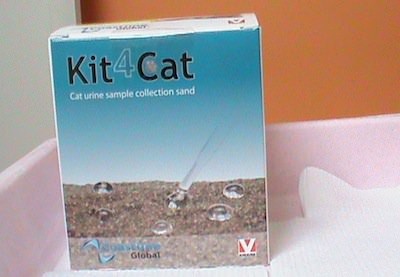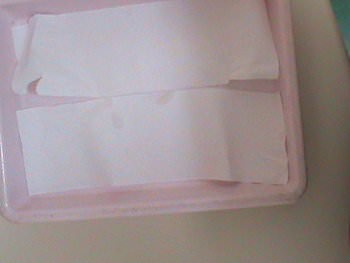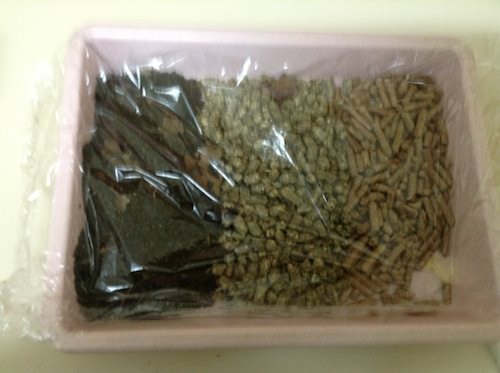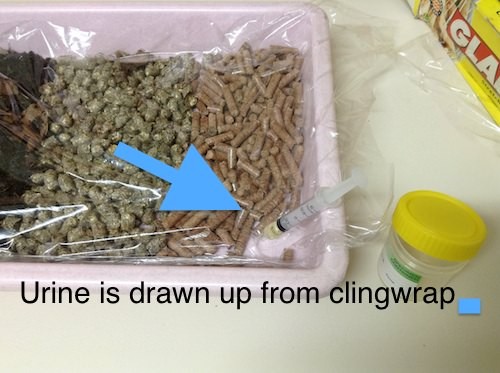This is Part 1 of my series on how to collect a cat urine sample at home. Part 2 covers the testing and measurement of urine samples with a particular focus on managing diabetic felines. Learn More…
What’s the best litter for collecting cat urine?
So, you have to collect your pet cat’s pee at home? It seems like “yuck” if you haven’t done it before, but collecting samples at home is particularly valuable for tracking the recovery from diabetes mellitus but you may also be asked by the vet to take samples for other situations. It only takes a little ingenuity and a willingness to get over the ‘yuckiness’ to be able to successfully track Fluffy’s wellbeing and with a little practice you will become an expert.
At the simplest level, all you need to begin is
- a clean and dedicated litter tray,
- non-absorbent litter,
- or even just a paper towel in a tray.
The following three examples demonstrate the types of collection methods you can use to successfully and easily prepare for an at home urine test. The easiest is a commercial solution – Kit4Kats – but there are also highly effective home grown options.
How to collect one sample in a two cat home
Collecting urine when there is more than one cat in the household can require ingenuity. After all –without watching closely, how do you know who’s pee it is?
This can be particularly difficult if you are looking for a spraying cat or one cat peeing on the carpet. Sniffing doesn’t work as too much of it will shut your nose down.
Using a black light
The original recommendations were to feed the cat Fluorescein (a non-toxic product used to determine the presence of corneal ulcers). The idea was that it made the urine fluoresce – which it does.
However, ALL urine fluoresces at different times – hence the use of ‘black lights to find that elusive pee spot around the house! (By the way – so do scorpions apparently. In fact, even human urine glows once it is dried and has dehydrated into uric acid crystals!)
So – this is not really reliable, as you want to collect a sample rather than just clean a mess.
How to be sure
Really, you need to be sure you have the right cat and the right sample so here are my sure fire methods for successfully collecting cat urine when there is more than one suspect or, one isn’t using the tray.
- ‘Video capture’ the event so you can see which cat is delivering.
- Keep cats isolated in one room and sample as described above. You should only need to do this for a short time although you need to watch out for stress from an unexpected separation.
- Visit the vet with the cat/s for a sampling direct from the bladder.
- And, of course, you can check for diabetes from the wet spots on the carpet or anywhere else.
How to test for diabetes in cats
Bringing your pet cat home after a diabetes diagnosis can be traumatic but ultimately rewarding – both for you and the cat. But, I promise that if you master these steps, cat peeing will become just another bonding and helpful moment in your day. Better still, Fluffy will be happy at home with your loving care.
Regular testing requires a little more thought and a supply of the right equipment. See our full guide for regularly checking glucose levels if your cat has diabetes.
What a difference a tray makes
Choosing the best litter for cat urine samples
 Option 1: Kit4Cat
Option 1: Kit4Cat
Kit4Cat ticks all the boxes:
- hydrophobic sand (makes the urine form into easy-to-collect balls)
- the collection system is included (pipettes and tubes)
- other versions can use dry (and not salted!) pumpkin seeds and aquarium gravel or glass beads
Option 2: Using the bulk cat litter your cat is used to
Sometimes in a Feline Friendly household, you and Fluffy really want to keep to the same tried and true successful ways. To much change is -er- Cat-astrophic!
So to achieve this, you can simply keep to your same litter and just cover it with clingwrap. (This is particularly useful for outdoor cats – just use actual soil or potting mix so they can imagine they are in the garden!)
Click on any image below to view the full gallery and step by step instructions
- Step 1: Cover your preferred litter with gladwrap (clingwrap)
- Step 2: Make sure you push the clingwrap down onto the litter surface so the cat does not claw through when using it.
- Step 3: The urine will pool into one of the dents in the soil and you will be able to syringe it out hygienically and simply.
- Step 4: Remove the sample with a syringe, then remove the clingwrap CAREFULLY making sure you don’t spill any on the soil or on your floor!
Using a simple paper towel
 There are a couple of important distinctions if you are using this method…
There are a couple of important distinctions if you are using this method…
1 Not too much towel so there is some urine still available to draw up and take to the vet
2. The sample is not suitable for culture, but is useful for microscopic examination for bacteria and inflammatory cells and to check the urine concentration. It’s an excellent marker for kidney function as well as checking for diabetic status.






